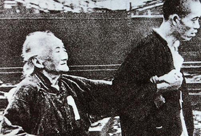 Martenitsa adds glamour to Bulgarian Embassy
Martenitsa adds glamour to Bulgarian Embassy
 Mysterious 'Dolan Tribe' in Xinjiang
Mysterious 'Dolan Tribe' in Xinjiang
 This is Shanghai
This is Shanghai
 Female attendants serving 'two sessions'
Female attendants serving 'two sessions'
 The many tears of DiCaprio
The many tears of DiCaprio
 Dan Dan's bittersweet opera life
Dan Dan's bittersweet opera life
 A dream wedding for a girl suffering from cancer
A dream wedding for a girl suffering from cancer
 Old photos of Anti-Japanese War (1937-1945)
Old photos of Anti-Japanese War (1937-1945)
 This is Beijing – Nanluoguxiang
This is Beijing – Nanluoguxiang
China reported a large trade deficit in February mainly due to distortion by the Chinese New Year holidays, marking the first deficit since April 2013, customs data showed on Saturday.
Last month, the trade deficit stood at 22.98 billion U.S. dollars, compared with a surplus of 14.8 billion U.S. dollars last February and 31.86 billion U.S. dollars this January, the General Administration of Customs (GAC) said in a statement.
Total trade dropped by 4.8 percent year on year to 251.18 billion U.S. dollars, with exports falling 18.1 percent and imports up 10.1 percent, according to the statement.
In January, foreign trade climbed 10.3 percent, with exports rising 10.6 percent and imports up by 10 percent, previous data showed.
"The Spring Festival factor contributed to large fluctuations in trade volume and the deficit last month," the GAC said.
The Spring Festival, or China's Lunar New Year, is the country's most important traditional festival for family reunions. It fell on Jan. 31 this year, and a holiday ran from Jan. 31 to Feb. 6.
Chinese companies followed their tradition of rushing to export before the holiday and prioritizing imports after it, the GAC added.
Bai Ming, a researcher with the Chinese Academy of International Trade and Economic Cooperation, attributed the drop in February also to a high base number a year earlier due to rampant over-invoicing.
Exports at this time last year were significantly inflated due to illicit transactions, so January's exports should have been weaker, according to some forecasters.
In the first quarter of 2013, over-invoicing through Hong Kong allowed exports to balloon by more than 20 percent year on year.
Figures from the National Bureau of Statistics showed that exports in February 2013 increased 21.8 percent from a year earlier.
The appreciation of the yuan also gave export companies and factories a hard time, Bai said.
In the first two months of 2014, total trade volume expanded 3.8 percent year on year to 633.57 billion U.S. dollars. Exports fell 1.6 percent, while imports rose 10 percent. Trade surplus narrowed 79.1 percent to 8.89 billion U.S. dollars.
Since February, the GAC has expanded the use of the yuan denomination in trade statistics by releasing the whole series of data in both the U.S. dollar and the yuan, a move that aims at promoting the international use of the Chinese currency.
Prior to that, all data were denominated in U.S. dollars, while only a few key figures, including export, import and trade surplus, were listed also in yuan.
Trade with the European Union, China's largest trade partner, rose 6.3 percent to 551.99 billion yuan (90.19 billion U.S. dollars) in the first two months, while that with the United States, its second-biggest trade partner, rose 4.8 percent to 499.05 billion yuan.
China's trade with the Association of Southeast Asian Nations, its third-largest trading partner, rose 4 percent year on year to 413.63 billion yuan, and trade with Japan edged up 2.9 percent to 290.77 billion yuan.
Earlier this month, the Ministry of Commerce said China's goods trade in 2013 reached 4.16 trillion U.S. dollars, overtaking the United States for the first time to become the world's largest goods trading nation, citing latest World Trade Organization figures.
The dramatic fluctuation in the monthly trade figure has caused some concerns about the health of the trade sector.
However, GAC spokesman Zheng Yuesheng played down the fluctuation, saying that trade growth will likely get back to normal after the holiday distortion goes away in March.
He added that government measures to promote trade, including enhancing trade facilitation and promoting cross-border e-commerce, will continue to contribute to steady trade growth in the future.
"Recovery in some major developed economies will also add to favorable conditions for exports," Zheng said.
The government work report delivered at the annual session of the National People's Congress on Wednesday set the target for this year's trade growth at 7.5 percent, lower than an 8-percent target for 2013 and an actual growth of 7.6 percent.
 Chaihe village, pure and peaceful fairyland in snow
Chaihe village, pure and peaceful fairyland in snow Belgians warmly welcome arrival of China's giant pandas
Belgians warmly welcome arrival of China's giant pandas Female marines receive tactical training in NW China
Female marines receive tactical training in NW China Blood memory: Nanjing Massacre in 1937
Blood memory: Nanjing Massacre in 1937 Top 10 pure beauties in showbiz
Top 10 pure beauties in showbiz British WWII veteran: I can't forgive Japan
British WWII veteran: I can't forgive Japan Tongban's dream of prosperity
Tongban's dream of prosperity Chinese frigate Yancheng holds drills in Mediterranean Sea
Chinese frigate Yancheng holds drills in Mediterranean Sea A visit to comfort woman's home in South Korea
A visit to comfort woman's home in South Korea Fairyland? Qingdao in sea of clouds
Fairyland? Qingdao in sea of clouds Top 10 most handsome faces in Asia in 2013
Top 10 most handsome faces in Asia in 2013 Female celebs with beautiful long legs
Female celebs with beautiful long legs Cat 'guardians' in Forbidden City
Cat 'guardians' in Forbidden City Large numbers of ancient coins excavated in Inner Mongolia
Large numbers of ancient coins excavated in Inner Mongolia Leisurely life beneath Zhonggulou, where time travels slower
Leisurely life beneath Zhonggulou, where time travels slowerDay|Week|Month